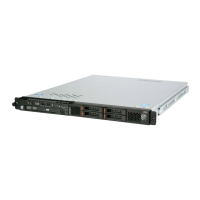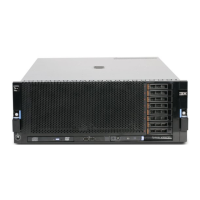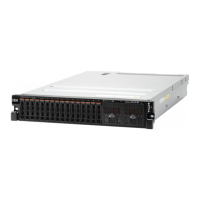• Follow the suggested actions in the order in which they are listed in the Action column until the problem is
solved.
• See
Chapter 4 “Parts listing, Lenovo System x3550 M3 Type 4254 and 7944” on page 403 to determine which
components are customer replaceable units (CRU) and which components are field replaceable units (FRU).
• If an action step is preceded by “(Trained service technician only),” that step must be performed only by a
Trained service technician.
• For additional memory troubleshooting information, refer to the “Troubleshooting Memory - IBM
BladeCenter and System x” document at
http://www.ibm.com/support/entry/portal/docdisplay?lndocid=MIGR-
5081319
.
• Go to the IBM support website at
http://www.ibm.com/supportportal/ to check for technical information, hints,
tips, and new device drivers or to submit a request for information.
Symptom
Action
The amount of system memory
that is displayed is less than
the amount of installed
physical memory.
Note: Each time you install or remove a DIMM, you must disconnect the server from
the power source; then, wait 10 seconds before restarting the server.
1. Make sure that:
• No error LEDs are lit on the operator information panel.
• No DIMM error LEDs are lit on the system board.
• Memory mirroring does not account for the discrepancy.
• The memory modules are seated correctly.
• You have installed the correct type of memory.
• If you changed the memory, you updated the memory configuration in the
Setup utility.
• All banks of memory are enabled. The server might have automatically
disabled a memory bank when it detected a problem, or a memory bank
might have been manually disabled.
• There is no memory mismatch when the server is at the minimum memory
configuration.
2. Reseat the DIMMs, and then restart the server.
3. Check the POST error log:
• If a DIMM was disabled by a systems-management interrupt (SMI), replace
the DIMM.
• If a DIMM was disabled by the user or by POST, reseat the DIMM; then, run
the Setup utility and enable the DIMM.
4. Check that all DIMMs are initialized in the Setup utility; then, run memory
diagnostics (see
“Running the diagnostic programs” on page 318).
5. Reverse the DIMMs between the channels (of the same microprocessor), and
then restart the server. If the problem is related to a DIMM, replace the failing
DIMM.
6. Re-enable all DIMMs using the Setup utility, and then restart the server.
7. (Trained service technician only) Install the failing DIMM into a DIMM connector
for microprocessor 2 (if installed) to verify that the problem is not the
microprocessor or the DIMM connector.
8. (Trained service technician only) Replace the system board.
Multiple rows of DIMMs in a
branch are identified as failing.
Note: The highest-numbered
DIMM failed disabling other
DIMM(s) in the same channel.
Note: Each time you install or remove a DIMM, you must disconnect the server from
the power source; then, wait 10 seconds before restarting the server.
1. Reseat the DIMMs; then, restart the server.
2. Remove the DIMM with lit error LED and replace it with an identical known good
DIMM; then, restart the server. Repeat as necessary. If the failures continue
after all identified DIMMs are replaced, go to step 4.
368 System x3550 M3Problem Determination and Service Guide

